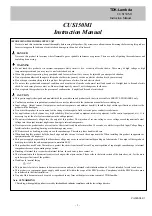
- 9 -
TDK-Lambda
CUS150M1
Instruction Manual
6. Wiring Method
(1)
The output load line and input line shall be separated each other and twisted individually to improve noise.
(2)
Use all lines as thick and short as possible to made lower impedance.
(3)
Noise can be reduced by attaching a capacitor to the load terminals.
(4)
For safety and EMI considerations, connect
with the terminal of protective earth of equipment firmly.
7. External Fuse Rating
Refer to the following fuse rating when selecting the external fuses that are to be used on input line. Surge current flows when line turns on.
Have to use slow-blow or time-lag type fuse, not fast-blow fuse. Fuse rating is considered by in-rush current value at line turn-on. Do not
select the fuse according to input current (RMS.) values under the actual load condition.
CUS150M1 series: 5A
8. Before concluding that the unit is at fault
(1)
Check if the rated input voltage is connected.
(2)
Check if the wiring of input and output is correct.
(3)
Check if the wire thickness is enough.
(4)
Check if the output current and output wattage dose not over specification.
(5)
Check if the output voltage adjust trimmer (V.ADJ) is properly adjusted. OVP might be triggered and output is shut down.
(6)
Audible noise can be heard when input voltage waveform is not sinusoidal wave.
(7)
Audible noise can be heard during Dynamic-Load operation.
(8)
Ensure that a large capacitor is not connected across the output terminals. Please use within maximum capacitance shown below.
Model CUS150M1-12
CUS150M1-18
CUS150M1-24
CUS150M1-36 CUS150M1-48
Maximum external capacitance
10000uF
6000uF
3000uF
1000
400uF
9. Altitude
CUS150M1 is safety approved for operation at below altitude.
- Up to 5000m by IEC60950-1 clearance requirement.
- Up to 4000m by IEC60601-1 clearance requirement.
Thermal evaluation should be considered for products operating at elevated altitudes above 2000m.








